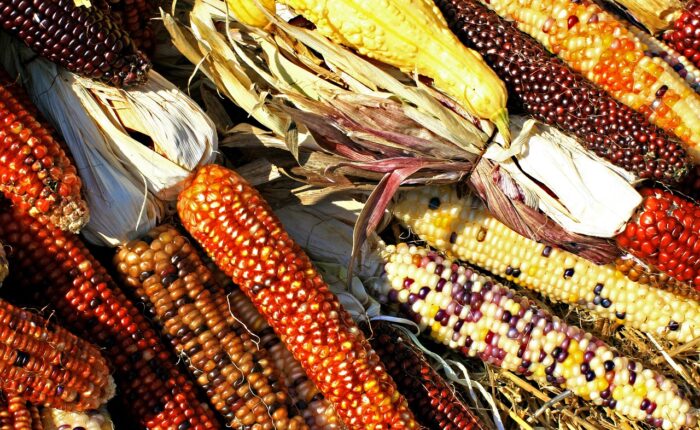Nutrition and Biodiversity

Unhealthy diets contribute to 11 million deaths worldwide and about 47,000 deaths in Canada each year. Diet related deaths are the most important cause of mortality globally. In addition, the world’s population is growing and is expected to reach about 10 billion by 2050 and today’s industrial agricultural methods are significantly damaging the environment. Unfortunately, the global industrial food production system – which farmers in Canada and around the world contribute to – fails to provide millions with healthy, safe, affordable, and sustainable diets. Food systems need to adjust to nourish people with high quality diets instead of merely feeding people while at the same time protecting and even enhancing the natural environment.
This means that producers and consumers of foods need to support the basis for nutrition, agriculture, and food security – known as agrobiodiversity. A definition of agrobiodiversity from the organization Biodiversity International is “the wealth of plants, animals and microorganisms used for food and agriculture.” The long-term sustainability of our food systems relies on agrobiodiversity. Transforming our food system towards greater agrobiodiversity requires a shift from current industrial agriculture – which has resulted in biodiversity loss and a few staple crops – towards a sustainable and resilient food system that preserves and uses diversity at all levels – the genetic, species, and agro-ecosystem (or farm) levels.
Significant amounts of agrobiodiversity are not being used and need to be supported. According to a press release from the UN Convention on Biodiversity “75% of Humanities’ food is generated from only 12 plants and 5 animal species.” When it comes to the at least 200,000 edible plant species humans only eat about 200 of these species. In addition, three crops – maize, rice, and wheat – account for more than half of the calories and proteins derived from plants. The press release also states that “the loss of diverse diets is directly linked to malnutrition and noncommunicable diseases such as diabetes, obesity and has a direct impact on the availability of healthy foods”.
Finally, the press release acknowledges that “locally varied food production systems, including related indigenous, traditional and local knowledge, and the diverse cultures and skills of women and men family farmers, are under threat.”
Why Is Agrobiodiversity Important For Nutrition
Agrobiodiversity is critical for nutrition. Genetic diversity of crops is important as it allows humans to consume a diverse array of foods to help avoid nutritional deficiencies. For example, beta-carotene content (which helps with vitamin A production) can differ by a factor of 60 between sweet potato varieties and the pro-vitamin A carotenoid of banana varieties can range between 1 microgram (one millionth of a gram) and 8,500 micrograms per 100 grams. In another example, the protein content of rice varieties can range from 5 to 13 percent.
Consumption of one variety of a species rather than another can mean the difference between nutrient deficiency and nutrient adequacy. Maintaining crop diversity also ensures that we maintain varieties that can fight pests and diseases as well as survive alongside climate change – these factors are a must to provide nutritious diets for future generations.
What Did We Do To Reduce Agrobiodiversity
Much of our agrobiodiversity has been lost – including plant and animal genetic diversity – due to the loss of diverse, local indigenous agricultural systems and traditions. The green revolution of the 1960s and 1970s to feed the world made use of high-yielding varieties of rice and wheat which replaced thousands of traditional indigenous crop varieties on a large scale. Traditional varieties are thus becoming extinct and replaced with uniform varieties. In addition, the current approach to agriculture is to produce cheaper food through the use of inputs such as fertilizers, pesticides, energy, land, and water. These industrial agriculture practices are the sole threat to 86% of species currently at risk of extinction and the rate of extinction today is higher than the average rate over the past 10 million years. Agrobiodiversity has also been significantly impacted by these practices. Consumers want vegetables of known shapes and sizes as well as inexpensive processed food products on a large scale which makes it harder to preserve agrobiodiversity. Other factors which affect agrobiodiversity also affect biodiversity in general. These factors include deforestation, climate change, and invasive species.
Next Steps
Canada should adopt several measures to enhance agrobiodiversity.
First, we need to support local diverse seed varieties suited for different regions of the country instead of just focusing on uniform varieties for the global food system. Consumers should have access to these local foods and should be encouraged to purchase these foods. This will help ensure Canada’s food self-sufficiency. Second, Canada must support internationally accepted biodiversity targets that make sustainable nutritious agriculture possible. These Aichi biodiversity targets include preserving the genetic diversity of cultivated plants, farmed and domesticated animals as well as of wild relatives. These targets also require restoring and safeguarding ecosystems that provide essential services, such as food. Third, the federal government should require farmers to adopt agricultural practices that preserve agrobiodiversity. Agrobiodiversity-friendly methods can help soils remain healthy and fertile, reduce pests and diseases, support pollinators which can significantly help food production, help adapt to climate change as well as help nutrition and sustainable food production in several other ways. Fourth, we need to quantify and measure agrobiodiversity over time to determine the impact of each measure adopted to see if the measure is increasing nutritious and sustainable diets.
Promoting agrobiodiversity is essential if we are to successfully feed a growing global population in an environmentally sustainable way. Action is needed now to address this challenge.
